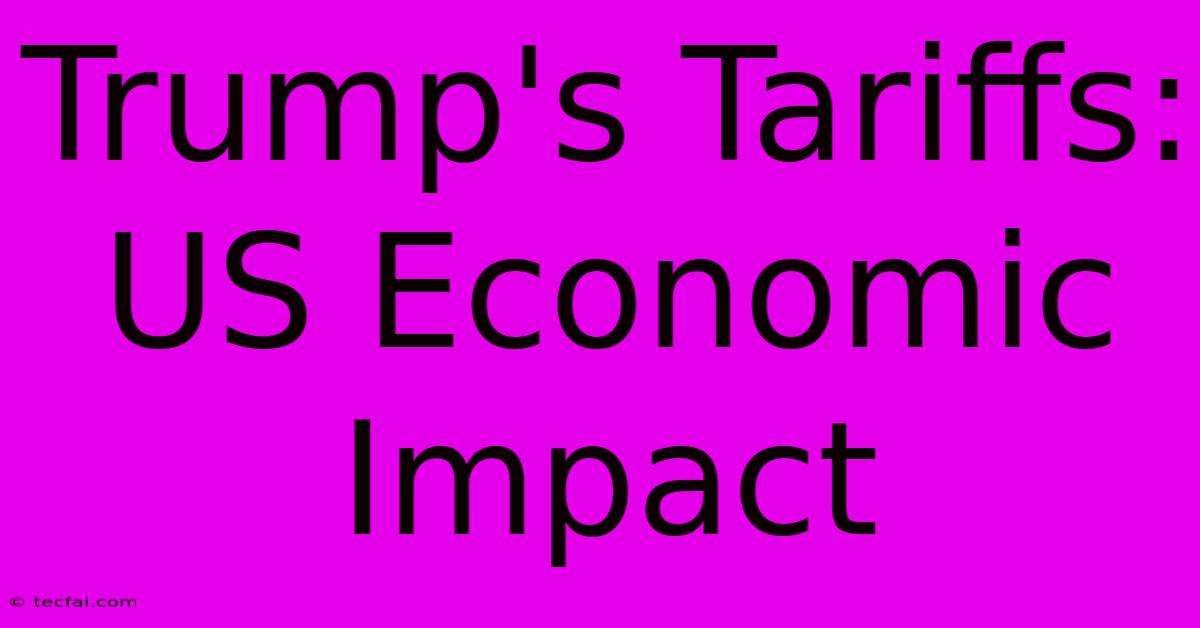Trump's Tariffs: US Economic Impact

Discover more detailed and exciting information on our website. Click the link below to start your adventure: Visit Best Website tecfai.com. Don't miss out!
Table of Contents
Trump's Tariffs: A Deep Dive into Their Impact on the US Economy
Donald Trump's presidency was marked by a significant trade policy shift: the imposition of tariffs on a vast array of imported goods. While proponents argued these tariffs would protect American industries and jobs, critics warned of negative consequences for consumers and the broader economy. This article delves into the multifaceted economic impact of Trump's tariffs, exploring both the intended benefits and the unintended repercussions.
The Rationale Behind the Tariffs
Trump's administration justified the tariffs primarily on the grounds of national security and addressing what it perceived as unfair trade practices by other countries, particularly China. The stated goals included:
- Protecting American industries: Tariffs aimed to make imported goods more expensive, thereby boosting demand for domestically produced alternatives. This was particularly targeted at industries like steel and aluminum.
- Reciprocating unfair trade practices: The administration argued that tariffs were necessary to counter what it considered unfair subsidies and trade barriers imposed by other nations.
- Reducing the trade deficit: A key objective was to shrink the US trade deficit by making imports less attractive.
Key Targets of Trump's Tariffs
The tariffs weren't uniformly applied. Some of the most significant targets included:
- China: A large-scale trade war with China saw tariffs imposed on hundreds of billions of dollars worth of Chinese goods. This included consumer goods, technology products, and industrial components.
- Steel and Aluminum: Tariffs were levied on steel and aluminum imports from numerous countries, ostensibly to protect domestic producers.
- Other countries: Tariffs were also imposed on goods from various other countries, including Canada, Mexico, and the European Union, often in response to perceived unfair trade practices or retaliatory measures.
The Economic Consequences: A Mixed Bag
The economic impact of Trump's tariffs is complex and debated. While some sectors experienced short-term benefits, the overall effects were largely negative, impacting various facets of the US economy:
Positive Impacts (Limited and Contested):
- Short-term boost to some domestic industries: Some US industries, particularly those directly protected by tariffs, saw a temporary increase in demand and production. However, this effect was often limited and came at a cost.
- Increased domestic production in specific sectors: Certain sectors experienced a rise in domestic production due to reduced competition from cheaper imports. This gain, however, was often offset by broader economic losses.
Negative Impacts (Significant and Widespread):
- Higher prices for consumers: Tariffs directly increased the cost of imported goods, leading to higher prices for consumers on a wide range of products. This reduced consumer purchasing power and dampened economic growth.
- Reduced competitiveness of US businesses: American businesses that relied on imported inputs saw their costs increase, making them less competitive in both domestic and international markets.
- Retaliatory tariffs and trade wars: Trump's tariffs triggered retaliatory measures from other countries, harming US exporters and disrupting global trade flows. This led to a decline in exports and increased uncertainty in the global market.
- Negative impact on investment and economic growth: The uncertainty created by the trade war discouraged investment and slowed economic growth. Businesses hesitated to make long-term commitments due to the unpredictable trade environment.
- Harm to agricultural sector: The trade war significantly impacted the US agricultural sector, as many countries retaliated by imposing tariffs on US agricultural exports.
Long-Term Effects and Unanswered Questions
The long-term consequences of Trump's tariffs are still unfolding. While some industries might have experienced temporary gains, the overall negative impact on consumer prices, business investment, and global trade relationships raises serious concerns. The true economic cost, including the long-term impact on innovation and productivity, remains a subject of ongoing research and debate.
Conclusion: A Complex Legacy
Trump's tariffs represent a significant departure from traditional US trade policy. While the intention was to protect American industries and jobs, the overall impact was far more nuanced and, for many economists, largely negative. The experience underscores the complexities of trade policy and highlights the need for a careful consideration of both the intended and unintended consequences of such measures. The legacy of these tariffs continues to shape the US economy and its relationship with the global trading system.

Thank you for visiting our website wich cover about Trump's Tariffs: US Economic Impact. We hope the information provided has been useful to you. Feel free to contact us if you have any questions or need further assistance. See you next time and dont miss to bookmark.
Featured Posts
-
Rod Stewart To Headline Glastonbury
Nov 27, 2024
-
Winnipeg Jets Forwards First Quarter
Nov 27, 2024
-
Update Wendy Williams Permanent Status Confirmed
Nov 27, 2024
-
Bonnie Blues Three Words Cause This Morning Stir
Nov 27, 2024
-
Barbra Banda Gender Test Outcome
Nov 27, 2024
